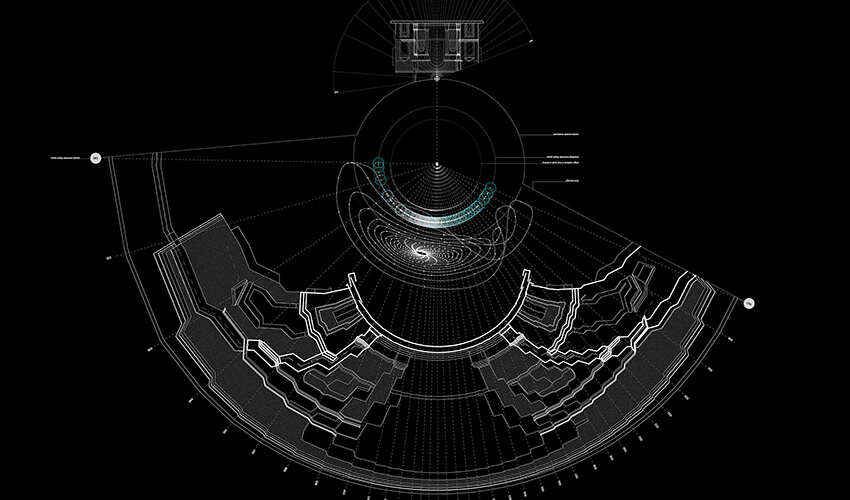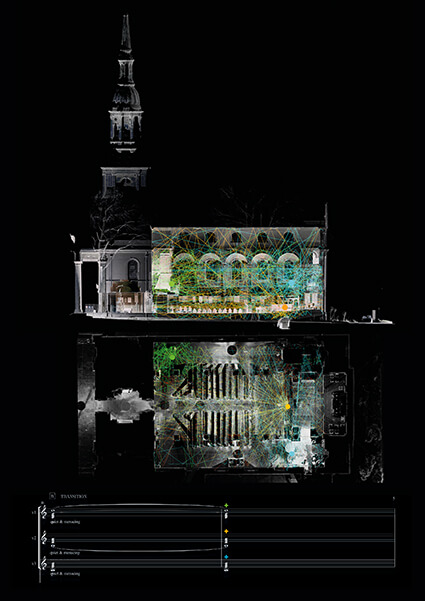Text by Adriana Ciotau

Emma-Kate Matthews is an architect, artist, and composer who has built an amazing array of transdisciplinary projects between architecture, acoustical engineering and music composition. This interconnection of fields is being explored and experimented with by EKM Works using innovative technologies.
It has been seven years since Emma-Kate founded the EKM practice, and since then, she tends to use the EKM Works in relation to all her solo projects, whether they are musical, design-based or architectural projects. Added to this, she specified that she is interested in the idea of the “practice” of EKM Works as a means of contextualising her work or at least for providing a space in which a set of conceptual frameworks can develop, grow and make sense of her projects as a network of ideas and methodologies. Most of her current research and associated projects set out to explore reciprocities between architecture and music, and for her to accomplish this work with a good level of depth and rigour, Emma-Kate regularly collaborates with practitioners in the related disciplines of acoustics and music performance.
Even though architecture and music share a lot of common ground, there (seemingly) isn’t yet a dedicated (transdisciplinary) practice where their interaction, on both a physical and conceptual level, can be formally discussed and practiced. When I talk about this kind of work I often use the coined term “Spatiosonic” as a bit of a gathering device for the skills, knowledge, expertise and ideas that come together in this overlap between architecture, music composition, performance and acoustics.
The interest in music as constructed sound & architecture as constructed space can be traced to Emma-Kate’s artistic practice and her academic career. She teaches at a Master in Architecture studio at the Bartlett of Architecture UCL along with her teaching partner teacher Nat Chard. This Master in Architecture studio has a distinct focus, and it is being identified by the research interest of the tutors, in this case, Emma-Kate and Nat Chard’s research interest.
Their Master in Architecture studio, known as unit X25, is focused on experimental practice where students can develop methodologies that resonate with the ideas and research questions they are interested in exploring. As tutors, Emma-Kate and Nat Chard encourage students to be comfortable with ‘speculative risk’ and to invent their own methods of drawing, modelling, making and developing their projects rather than relying too much on the tried and tested, conventional methods.


Added to this, her PhD research is a huge focus, and it’s giving her the opportunity for more serious interrogation of some of the complex and fascinating overlaps between architecture and music, as can be seen in the following description of her research project Spatiosonic Constructs:
This body of research is concerned with discovering and exploiting creative reciprocities between music as constructed sound, and architecture as constructed space. Historically, architectural space has played a highly active role in influencing the experience and composition of music. The Dutch Renaissance composer Adrian Willaert is famed for having supposedly invented polychoral, antiphonal music as a response to the spatially-opposed positioning of choir lofts in St Mark’s Basilica in Venice. Conversely, architects and engineers have long acknowledged the desires of music in space.
Long before Acoustics was a formally recognised discipline, Roman architect and engineer Vitruvius discusses a method for enhancing the sonic character of theatres and performance spaces by embedding “echea” or acoustic vases in the walls. Despite these examples, only a small handful of spatiosonic practitioners have managed to rigorously explore interactive parallels between musical space and physical space in their work. American composer Henry Brant produced many spatial compositions, with a view to exploring the idea that aspects of physical space (particularly distance and direction) are as compositionally active as the musical elements of tone and timbre. In contrast to the above examples, our experience of music is becoming more “virtual” or divorced from physical, spatial reality.
Our lives are increasingly saturated with the availability of digital media and we are largely inseparable from the portable technologies which enable us to create and consume media on demand whenever, wherever. A continuing trend towards “virtual listening” results in a disconnect between the practices of designing spaces for music and composing music for live performance. This research is explored through the composition and choreography of physical, and musical performances. These performances are hypothesised, constructed and examined using a range of analytical analogue and digital techniques from predictive models of acoustic simulation to interrogate the results of the performances through the analysis of ambisonic recordings, spatiotemporal drawings and audience feedback.
The performed compositions are referred to as “constructions”, and each one establishes the terms by which sonic media and architectural space might influence each other. With these constructions, architecture is activated by musical desires. Simultaneously, music is composed and performed to access and exploit spatiotopic phenomena.
Emma-Kate hosted several events in the last years, and they were organised to bring select groups of talented musicians, dancers, architects and designers to discuss the overlap between their particular areas of operation. Therefore, we could bring forward events resulting from EMK practice focused on transdisciplinary collaboration, such as the EDGE to EDGE event and the Keeping Time: Calibrating time in music and spatial practice’ event. We could talk about a style of playing developed and encouraged to be presented at these events.
Both of these events (and a few others since!) were organised to bring select groups of talented musicians, dancers, architects, academics and designers to discuss the overlap between their particular areas of operation. In formalising these conversations as events, it’s possible for practitioners who might not normally get to work together to demonstrate and discuss their projects side-by-side physically.
The reason for choosing the churches, as performance spaces, for her practice and events, in particular the Shoreditch Church, as Emma Kate describes it, is based on its acoustic qualities – the interior has a reverberation time of around 3 seconds which is particularly present for higher frequencies, and its rich history as a venue which has supported the performing arts for many centuries, despite being rebuilt several times!
Quite a few Tudor actors are buried in its grounds, such as Shakespeare’s contemporaries James and Richard Burbidge. Just to add to its acoustic intrigue, its bells are also mentioned in the nursery rhyme ‘Oranges and Lemons’ in the line “when I grow rich, say the bells of Shoreditch”. But to bring us back to the present day for a moment: making these events open to the public also opens up the discussion and provides opportunities to introduce new and experimental work to audiences who might not otherwise encounter it.
Her most recent piece has been commissioned by Musicity and Culture Mile in association with the Barbican. Added to this, the piece launches on the 18th May at the Barbican’s Sound Unbound festival and forms part of Culture Mile’s Play the Mile season which runs until 25 August. Musicity x Culture Mile celebrates work which combines architectural and musical ideas. Emma-Kate is really excited about this particular event, she will be presenting her work alongside other musicians and sound artists who are similarly interested in what she refers to as “Spatiosonics”, as Emma-Kate specified.
Residencies and commissions provide great opportunities to develop pieces of work for, and with specific groups. The pieces that Emma-Kate developed with the London Graduate Orchestra and London City Orchestra were very different. They resulted from a collaborative, experimental process where they developed and tested ideas through workshops, drawings and scores. Both pieces involved a lot of digital simulation as a predictive tool. Therefore, Emma-Kate could test things such as how the sound reflects within the performance space and which frequencies are particularly subject to reflection before heading into rehearsals and workshops.
Her recent piece for Musicity and Culture Mile makes more explicit use of ambisonic simulation tools, not just as a way of predicting and prototyping how sound will behave in a space, but this time to partially define the musical aesthetic of the piece, as Emma-Kate specifies.
Added to all these, Emma-Kate said that Musicity provided her with an “Impulse Response” file which was recorded in the Barbican foyer and provided a profile of which frequencies are most intensely reflected and how long the reflections take to decay in that particular space. This information influenced the range of notes that Emma-Kate used for the harmonic and melodic themes in the piece, as she wanted to maximise the potential for reverberation by using frequencies that she knows will be reflected more. It will be particularly interesting to hear the piece played back in the space to see if the overlay of the result of the simulation and the immediate acoustic response of the space will enhance the potential for reverberation or not!
Emma-Kate said that when she is not writing her own composition, she listens to a lot of music throughout the day, almost constantly. Some obvious composition /classical influences would include Krzysztof Penderecki, Anton Webern, Witold Lutosławski and Jonny Greenwood. She has also recently discovered some really interesting works by Yasuaki Shimizu, particularly the “Music for Commercials” album. She also has quite a fascination for library music. Finally, when she is not writing music, she plays bass and the drum kit, and she has a huge collection of more jazz and fusion-oriented favourites, including the work of Elvin Jones, Tony Williams, the Yellowjackets, Louis Cole, Ari Hoenig, Jaco Pastorius and Weather Report.






